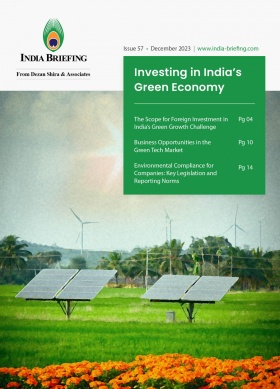Capital Gains Tax in India: An Explainer
On July 23, 2024, India’s Minister of Finance Nirmala Sitharaman presented the country’s Union Budget for FY 2024–25 in parliament, announcing significant changes to the capital gains tax. On August 6, a follow-up announcement brought clarity on indexation benefits.
We explain the latest changes to India’s capital gains tax regime that will impact financial investors due to revised tax rates, holding periods, and relevant reporting and compliance requirements.
Union finance minister Nirmala Sitharaman presented her seventh consecutive union budget document in the Indian parliament on July 23, 2024. In her speech, Sitharaman announced changes in the capital gains tax for nearly all asset classes. This includes a change in the definition of holding periods for short-term capital gains (STCG) and long-term capital gains (LTCG).
In India, any profit or gain arising from the sale of a capital asset is deemed as capital gains and is charged to tax under the Income-tax Act, 1961. They are classified as short-term capital gains or long-term capital gains, depending on the period for which the capital asset has been held.
According to the Income-tax Act, 1961, a capital asset is any kind of property held by an individual, such as buildings, lands, bonds, equities, debentures, and jewelry. It excludes stock-in-trade, agricultural land, and certain specified bonds.
The new provisions for taxation of capital gains come into force from July 23, 2024 and shall apply to any transfer made on or after July 23, 2024.
Changes in the tax rates and holding period
Short-term gains on certain financial assets will now attract a tax rate of 20 percent, while the applicable tax rate for all other financial and non-financial assets remains unchanged.
Previously, different capital assets had to be held for varying periods to qualify as STCG or LTCG. For example, long-term capital gains were defined as gains from listed equity shares held for more than 12 months and gains from unlisted bonds held for more than 36 months.
According to the Union Budget 2024-25, there will now be only two holding periods—12 months and 24 months—to determine whether capital gains are classified as long-term or short-term. This means that all listed assets must be held for at least 12 months for the gains to be considered long-term capital gains.
This change will apply to:
- Listed stocks
- Listed bonds
- Equity exchange-traded funds (ETFs)
- Gold ETFs
- Bond ETFs
- Real estate investment trusts (REITs)
- Infrastructure investment trusts (InvITs)
Revised rate of taxation
In India, tax on capital gains depends on two factors: the nature of the capital asset and the period for which it has been held. Until July 23, 2024, long-term capital gains on properties held for over two years were taxed at 20 percent after indexation. The new changes in capital gains tax include:
- The long-term capital gains exemption on financial assets has been raised from INR 100,000 (US$1194.3) to INR 125,000 (US$1492.9) per year.
- Listed financial assets held for more than a year are now considered long-term.
- Unlisted financial assets and all non-financial assets must be held for at least two years to be considered long-term.
- Unlisted bonds, debentures, debt mutual funds, and market-linked debentures will be taxed on capital gains at the applicable rates, regardless of the holding period.
|
New tax rates on capital gains |
||||
|
Nature/Class of the asset |
Long-term capital gains (LTCG) |
Short-term capital gain (STCG) |
||
|
Tax rate |
Holding period |
Tax rate |
Holding period |
|
|
Securities such as equities shares, units of equity oriented mutual funds and units of business trusts |
12.5 percent |
Over 12 months |
20 percent |
12 months or less |
|
Listed bonds and debentures |
12.5 percent |
Over 12 months |
Slab rates |
24 months or less |
|
Unlisted shares (including foreign shares), immovable property (land, building, house), and gold/bullion and any other non-financial assets |
12.5 percent (without indexation) |
Over 24 months |
Slab rates |
24 months or less |
|
Unlisted debentures/bonds/MLDs and specified MF |
Slab rate irrespective of holding period |
|||
Update on indexation benefits
The finance minister, in her budget speech, also proposed the complete removal of the indexation benefit for the cost of acquisition across all asset classes. However, on August 6, 2024, it was announced that taxpayers can choose between paying a 20 percent LTCG tax with indexation on property sold before July 23, 2024, or a 12.5 percent LTCG tax without indexation.
Indexation adjusts the purchase price of an asset, like property, to account for inflation over time. This adjusted price is then used to calculate the profit (capital gains) from selling the asset, providing a more accurate value by considering inflation.
This adjusted price is based on the Cost Inflation Index (CII) provided by the central government. CII measures price increases since the base year (2001-2002).
Tax exemption options on LTCGs
On August 6, 2024, it was announced that taxpayers can choose between paying a 20 percent LTCG tax with indexation on property sold before July 23, 2024, or a 12.5 percent LTCG tax without indexation. This announcement comes after the central government announced that it would remove the indexation benefit on LTCGs [Union Budget 2024].
Those who choose to pay 12.5 percent LTGC tax without the indexation benefit can still avail exemptions under certain sections of the Income Tax Act, 1961. This may allow taxpayers to potentially pay zero taxes on capital gains.
1. Section 54: The section offers exemption on long-term capital gains from selling a residential property if the sale proceeds are reinvested in another residential property in India within specified timeframes.
This property must be built within three years of the sale date, purchased within two years of the sale date, or acquired within a year of the sale date. A taxpayer has the option to invest in two residential properties if their capital gain is less than INR 20 million (US$238,227). This is a one-time option.
The quantum of exemption under this section shall be the lower of:
- Capital gain; or
- Cost of new asset (limited to INR 100 million or US$1.1 million)
Further, taxpayers can park the sale proceeds temporarily in the Capital Gains Accounts Scheme (CGAS) deposit till they find a suitable property to purchase or construct. This must be done before the due date of furnishing the tax return for the financial year in which the sale occurred.
2. Section 54EC: The section provides exemption on long-term capital gains from selling land, buildings, or both, if the proceeds are invested in specified bonds, such as Rural Electrification Corporation (REC), Power Finance Corporation (PFC) or of Indian Railway Finance Corporation (IRFC), within six months.
The quantum of exemption under this section shall be the lower of:
- Capital gain; or
- Cost of bonds
These bonds carry a coupon rate of 5.25 percent per annum and such interest is taxable. The exemption is capped at INR 5 million (US$59,556), with a five-year lock-in period.
3. Section 54F: This applies to long-term capital gains from selling all capital assets (including shares, mutual funds) except residential properties. The sale proceeds must be reinvested in a residential property in India. The property must be constructed within three years of the date of sale or to be purchased within two years from the date of sale or to have been purchased within one year before the date of sale.
Taxpayers can combine exemptions from different sections if they meet the respective conditions, potentially reducing their capital gains taxes significantly.
When will the changes come into effect?
Changes in capital gains tax rates and holding periods will take effect on July 23, 2024, except for gold and international funds. The changes to long-term capital gains will come into effect starting April 1, 2025.
Calculating capital gains for NRIs
Non-Resident Indians (NRIs) can invest in the Indian capital markets provided they have a PAN card and complete their eKYC verification. An NRI’s income taxes in India depend on their residential status for the year as per income tax regulations. If an individual is classified as a ‘resident,’ their global income is taxable in India. If classified as an ‘NRI,’ only the income earned or accrued in India is taxable.
Taxable income for NRIs includes:
- Salary received in India or for services provided in India
- Income from house property in India
- Capital gains from transferring assets situated in India
- Interest from fixed deposits or savings accounts in India
In the Union Budget 2024-25, the finance minister proposed changes to the taxation of certain capital gains for NRIs, aiming to bring parity between the tax structures for residents and non-residents. The new tax rate will apply only to transfers made on or after July 23, 2024.
|
Income |
For transfers taking place before July 23, 2024/Rate of TDS |
For transfers taking place on or after July 23, 2024/ Rate of TDS |
|
Long-term capital gains referred to in section 115E |
10 percent |
12.5 percent |
|
Long-term capital gains referred to in sub-clause (iii) of clause (c) of subsection (1) of section 112 |
20 percent |
12.5 percent |
|
Long-term capital gains referred to in section 112A exceeding INR 100,000 (US$1194.3) |
10 percent |
12.5 percent |
|
Long-term capital gains [not being long term capital gains |
20 percent |
12.5 percent |
|
Short-term capital referred to in section 111A |
15 percent |
20 percent |
Long-term capital gains not covered under specific exemptions will see a reduced tax rate from 20 percent to 12.5 percent. The Union Budget 2024 announcement emphasized achieving parity in taxation between residents and non-residents by amending section 115E (of the Income-tax Act 1961) to align long-term and short-term capital gains tax rates.
Additionally, to improve ease of doing business and ensure better compliance, the budget proposed to reduce the rates of tax deduction at source (TDS), except for specific sections like TDS on salary, virtual digital assets, lottery winnings, racehorses, transfer of immovable property, and payments to non-residents.
(US$1 = INR 83.73)
(This article was originally published in June 2017. It was last updated August 7, 2024.)
About Us
India Briefing is one of five regional publications under the Asia Briefing brand. It is supported by Dezan Shira & Associates, a pan-Asia, multi-disciplinary professional services firm that assists foreign investors throughout Asia, including through offices in Delhi, Mumbai, and Bengaluru in India. Dezan Shira & Associates also maintains offices or has alliance partners assisting foreign investors in China, Hong Kong SAR, Vietnam, Indonesia, Singapore, Malaysia, Mongolia, Dubai (UAE), Japan, South Korea, Nepal, The Philippines, Sri Lanka, Thailand, Italy, Germany, Bangladesh, Australia, United States, and United Kingdom and Ireland.
For a complimentary subscription to India Briefing’s content products, please click here. For support with establishing a business in India or for assistance in analyzing and entering markets, please contact the firm at india@dezshira.com or visit our website at www.dezshira.com.
- Previous Article Tax Dispute Resolution Scheme for Contractors in Government Procurement in India
- Next Article Eight National Highway Projects Sanctioned, Expected to Boost India’s Connectivity








